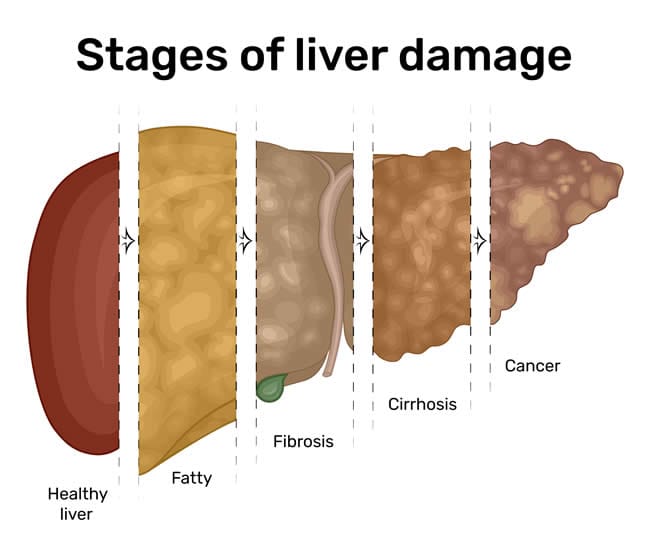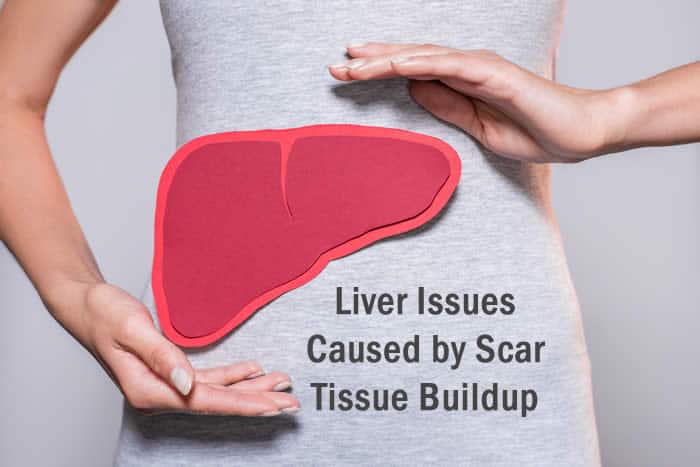
Previous
Exercise Moves & Yoga Poses Good for Liver Health

Next
Medications to Avoid with Fatty Liver Disease
Liver Issues Caused by Scar Tissue Buildup
Scar tissue in your liver can make it difficult to perform its vital functions. Learn about six liver issues caused by scar tissue buildup.
If you get a cut or burn, the body builds scar tissue to help heal and repair the damaged area. In this way, scar tissue is good. But scar tissue is not so beneficial when it builds up in internal organs such as the liver, which is what occurs in many liver issues.
What happens if you have liver scar tissue?
When there is scar tissue buildup in the liver, it makes it harder for blood and oxygen to flow through. This makes it more difficult for the liver to perform vital functions such as processing your blood, metabolizing the nutrients you consume, and filtering out unhealthy toxins. (1)
If the portal vein system—which is responsible for delivering blood to the liver—becomes compressed enough by scar tissue, it can lead to portal hypertension. (2) Symptoms of portal hypertension include swelling of the abdomen and legs, dilated veins around the navel, gastrointestinal bleeding, and more.
6 Liver Issues Caused by Scar Tissue Buildup
Certain conditions are characterized by a buildup of scar tissue on the liver. Here are some to consider.
- Liver Fibrosis. Fibrosis is a term that refers to scar tissue development. When the liver is inflamed, signals are sent to repair cells to deposit more collagen. In cases of constant inflammation, these signals are also constant, causing so much collagen to deposit that the tissue stiffens. This leads to liver fibrosis which, in early stages, is typically mild to moderate and generally goes undetected because most people have no symptoms. (3)
- Hepatitis C. The hepatitis C virus causes inflammation in the liver. Although this liver issue is highly treatable, many people with the hep C virus don’t know they have it because, like liver fibrosis, they have no symptoms. This can allow the condition to progress over time and, if it goes undetected and untreated for years, it can lead to liver scarring. (4)
- Nonalcoholic Steatohepatitis. Nonalcoholic steatohepatitis (NASH) is a form of nonalcoholic fatty liver disease (NAFLD) that involves not just fatty liver, but also liver inflammation and damage. The inflammation and damage that occurs with NASH can lead to liver scarring. (5)
- Cirrhosis. If liver scarring progresses or builds up enough, it can cause cirrhosis. While cirrhosis is often associated with drinking heavy amounts of alcohol consistently over time, this isn’t its only cause. Nonalcoholic causes of cirrhosis include NASH, chronic hepatitis C or B infections, genetic disorders, and even cardiovascular disease. (1)
- Hepatocellular Carcinoma. You may have heard of hepatocellular carcinoma as it is the most common type of liver cancer. This cancer is more common in people with chronic liver disease, with the risk also being higher in people with liver scarring due to hepatitis B or C. (6)
- Liver Failure. Acute or rapid liver failure does occur but is not as common as chronic liver failure, which is when liver function continues to decline over time, in conjunction with liver scarring. (7) In cases of liver failure, a liver transplant may be needed.

Is Liver Scar Tissue Buildup Reversible?
If left untreated, scar tissue on liver continues to build and expand, replacing more and more healthy liver tissue over time and further impacting liver function. (3) For patients with liver diseases like those named above, certain drugs and other treatments can help keep their condition from causing further liver scarring, but there are currently no options on the market that can reverse scar tissue buildup. (8)
Mesenchymal Stem Cell Transplant
That said, many researchers are working to change this. For example, one of the strategies they’re exploring is mesenchymal stem cell transplant, which are cells that help protect liver function while also having anti-inflammatory properties that may reverse liver fibrosis. (9)
In the meantime, there are several actions you can take to promote liver health, potentially stopping scar tissue from forming in the first place. They include maintaining a healthy weight, eating a balanced diet, exercising regularly, and avoiding contact with toxins that can harm the liver, such as insecticides, chemicals, and cigarette smoke. (10)
Taking a supplement may be beneficial as well. Natural Wellness offers a variety of liver support supplements, including UltraThistle, Clinical LiverSupport, and more.
(1) Cleveland Clinic. (2023, July 26). Cirrhosis of the Liver. Retrieved August 09, 2023, from https://my.clevelandclinic.org/health/diseases/15572-cirrhosis-of-the-liver
(2) Johns Hopkins Medicine. (n.d.). Portal Hypertension. Retrieved August 09, 2023, from https://www.hopkinsmedicine.org/health/conditions-and-diseases/portal-hypertension
(3) American Liver Foundation. (2022, August 09). Fibrosis (Scarring). Retrieved August 09, 2023, from https://liverfoundation.org/about-your-liver/how-liver-diseases-progress/fibrosis-scarring/
(4) Mayo Clinic. (2021, August 31). Hepatitis C. Retrieved August 09, 2023, from https://www.mayoclinic.org/diseases-conditions/hepatitis-c/symptoms-causes/syc-20354278
(5) National Institute of Diabetes and Digestive and Kidney Diseases. (2021, April). Definition & Facts of NAFLD & NASH. Retrieved August 09, 2023, from https://www.niddk.nih.gov/health-information/liver-disease/nafld-nash/definition-facts
(6) Mayo Clinic. (2023, April 28). Liver Cancer. Retrieved August 09, 2023, from https://www.mayoclinic.org/diseases-conditions/hepatocellular-carcinoma/cdc-20354552
(7) University of Chicago Medicine. (n.d.). Liver Failure. Retrieved August 09, 2023, from https://www.uchicagomedicine.org/conditions-services/liver-diseases/liver-failure
(8) Berumen, J., Baglieri, J., Kisseleva, T., Mekeel, K. (2020, July 26). Liver Fibrosis: Pathophysiology and Clinical Implications. WIREs Mechanisms of Disease. doi:10.1002/wsbm.1499
(9) Hu, C., Zhao, L., Duan, J., Li, L. (2019, January 11). Strategies to Improve the Efficiency of Mesenchymal Stem Cell Transplantation for Reversal of Liver Fibrosis. Journal of Cellular and Molecular Medicine. doi:10.1111/jcmm.14115
(10) American Liver Foundation. (2021, June 24). 13 Ways to a Healthy Liver. Retrieved August 09, 2023, from https://liverfoundation.org/resource-center/blog/13-ways-to-a-healthy-liver/







